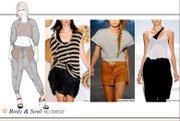Stylesight's Runway Roadmap
Visitors to the Los Angeles International Textile Show got a jump start on 2011 with Stylesight’s “Runway Roadmap” seminar. The New York–headquartered trend-forecasting company mapped out trends for womenswear for Spring 2011 and presented a sneak peek at Fall/Winter ’11. Stylesight Vice President of Global Trends Renee Labbe presented the key trends of the season as coordinated by Senior Vice President Trend Analysis Sharon Graubard.
For Spring 2011, Graubard found inspiration in designer Bonnie Cashin. The ideals of the designer, who is known as the mother of American sportswear, still resonate for the modern-day woman. Silhouettes are clean and timeless, clothing is layered and easy to wear, and ethnic garments are incorporated into the wardrobe. The presentation outlined five key trends for the season with various inspirations and cultural influences along with silhouette direction and key images from the Spring ’10 runways. Must-have textiles including eco-materials were covered as well as directional fabrics, colors and prints for the season.
bull; In “Studio Art,” Cashin’s 1950s modern-yet-classic simplicity is a focal point. Sturdy fabrics and timeless silhouettes embody the mid-century modern aesthetic. Boxy jackets, A-line skirts and a focus on craftsmanship characterize the look. The classic white men’s shirt and easy pants emphasize femininity and a sense of confidence through roomy, forgiving shapes. Industrial details such as Cashin’s brass toggle and fabrications such as perforated leathers, DIY recycled materials and organic linens are important.
bull; The “Soft Grunge” trend emphasizes a revival of the late ’80s/early ’90s grunge era with a soft, feminine twist. Cashin’s penchant for layering is emphasized by pairing flannels and thermals with softly feminine day bras and floral-printed dresses. References include designer Ossie Cark, the “Gypset Style” book and Kurt Cobain. Arty cardigans, mini and maxi skirts, loose pajama pants, and menswear-inspired pinstripes are key looks.
bull; Exotic locales such as Africa provide inspiration for the “Bongo Bakongo” trend. Cashin was an avid traveler, and her modernist aesthetic is channeled by way of Yves St. Laurent’s clean and chic safariennes and the colorful and graphic tribal prints recently seen on the runways at Balenciaga, Givenchy and Dries Van Noten. Important references include Daniele Tamagni’s book “Gentleman of Bakongo,” musician and human-rights activist Fela Kuti, and Alexander McQueen’s digital prints. Key pieces include the trench dress, safari suit, ceremonial-occasion skirt, sarong and jodhpur pants. Interesting eco-fabrications are made from salmon leather and food fibers derived from tropical inspiration.
bull; In “Body & Soul,” modern high-performance classics become high-style basics. Cashin, who studied dance, was very body-conscious. The trend translates her understanding of the body in motion to clothing for the strong modern woman who is active throughout the day. Performance-inspired clothing—such as the sweatshirt, tennis skirt and sports bra—are key looks. Scuba inspiration surfaces, and corsetry evolves into shapewear to support the body. Alexander Wang’s activewear-inspired collection for Spring 2010 was a key reference.
bull; The dark side of nature is a focus for the final trend concept of the season. “Moody Nature” is inspired by eroded surfaces and organic shapes and textures found in nature. It’s a dark theme where lightning bolts and hurricanes reflect the changing natures of the times. Inspiration includes the Rorschach ink blot, Hussein Chalayan’s 1993 debut collection at Central Saint Martens and textured prints by designers such as Peter Plilotto. The category included dark, turbulent tees with lighting-bolt motifs, pencil skirts made in high-stretch materials, organic collage effects, positive and negative prints, and kimono elements combined into tops and dresses.
For Fall 2011, trends evolve into four key concepts: “Composition,” “Evolution,” “Hyperreal” and “Rave.” “Composition” is an evolution of the mid-century modernist aesthetic of “Studio Art” in a dark earthy palette accented with cool tropical shades. “Hyperreal” combines intense saturated shades into a fantastical “Alice In Wonderland” hybrid world where man meets animal. In “Evolution,” primitive and futurism are mixed together with emphasis on tribalism. And the late-’80s/early-’90s era inspires a “Rave” trend with intense sporty brights and cool clinical primary tones.—N. Jayne Seward






















